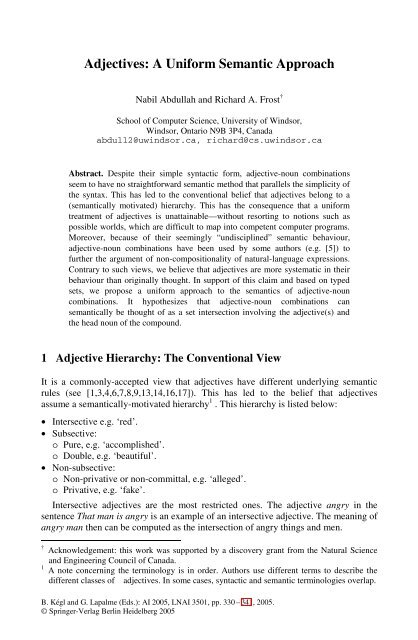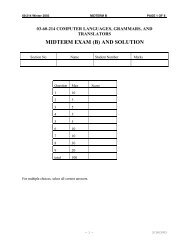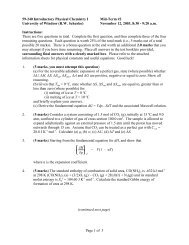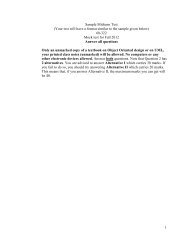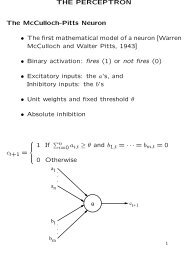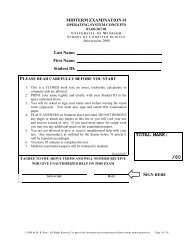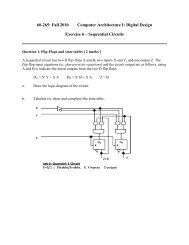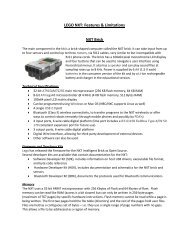Adjectives: A Uniform Semantic Approach - University of Windsor
Adjectives: A Uniform Semantic Approach - University of Windsor
Adjectives: A Uniform Semantic Approach - University of Windsor
You also want an ePaper? Increase the reach of your titles
YUMPU automatically turns print PDFs into web optimized ePapers that Google loves.
<strong>Adjectives</strong>: A <strong>Uniform</strong> <strong>Semantic</strong> <strong>Approach</strong><br />
Nabil Abdullah and Richard A. Frost †<br />
School <strong>of</strong> Computer Science, <strong>University</strong> <strong>of</strong> <strong>Windsor</strong>,<br />
<strong>Windsor</strong>, Ontario N9B 3P4, Canada<br />
abdull2@uwindsor.ca, richard@cs.uwindsor.ca<br />
Abstract. Despite their simple syntactic form, adjective-noun combinations<br />
seem to have no straightforward semantic method that parallels the simplicity <strong>of</strong><br />
the syntax. This has led to the conventional belief that adjectives belong to a<br />
(semantically motivated) hierarchy. This has the consequence that a uniform<br />
treatment <strong>of</strong> adjectives is unattainable—without resorting to notions such as<br />
possible worlds, which are difficult to map into competent computer programs.<br />
Moreover, because <strong>of</strong> their seemingly “undisciplined” semantic behaviour,<br />
adjective-noun combinations have been used by some authors (e.g. [5]) to<br />
further the argument <strong>of</strong> non-compositionality <strong>of</strong> natural-language expressions.<br />
Contrary to such views, we believe that adjectives are more systematic in their<br />
behaviour than originally thought. In support <strong>of</strong> this claim and based on typed<br />
sets, we propose a uniform approach to the semantics <strong>of</strong> adjective-noun<br />
combinations. It hypothesizes that adjective-noun combinations can<br />
semantically be thought <strong>of</strong> as a set intersection involving the adjective(s) and<br />
the head noun <strong>of</strong> the compound.<br />
1 Adjective Hierarchy: The Conventional View<br />
It is a commonly-accepted view that adjectives have different underlying semantic<br />
rules (see [1,3,4,6,7,8,9,13,14,16,17]). This has led to the belief that adjectives<br />
assume a semantically-motivated hierarchy 1 . This hierarchy is listed below:<br />
• Intersective e.g. ‘red’.<br />
• Subsective:<br />
o Pure, e.g. ‘accomplished’.<br />
o Double, e.g. ‘beautiful’.<br />
• Non-subsective:<br />
o Non-privative or non-committal, e.g. ‘alleged’.<br />
o Privative, e.g. ‘fake’.<br />
Intersective adjectives are the most restricted ones. The adjective angry in the<br />
sentence That man is angry is an example <strong>of</strong> an intersective adjective. The meaning <strong>of</strong><br />
angry man then can be computed as the intersection <strong>of</strong> angry things and men.<br />
†<br />
Acknowledgement: this work was supported by a discovery grant from the Natural Science<br />
and Engineering Council <strong>of</strong> Canada.<br />
1<br />
A note concerning the terminology is in order. Authors use different terms to describe the<br />
different classes <strong>of</strong> adjectives. In some cases, syntactic and semantic terminologies overlap.<br />
B. Kégl and G. Lapalme (Eds.): AI 2005, LNAI 3501, pp. 330 – 341, 2005.<br />
© Springer-Verlag Berlin Heidelberg 2005
<strong>Adjectives</strong>: A <strong>Uniform</strong> <strong>Semantic</strong> <strong>Approach</strong> 331<br />
The second class <strong>of</strong> adjectives is called subsective. They are so called because all<br />
that can be said about them is that the denotation <strong>of</strong> an adjective-noun combination is<br />
a subset <strong>of</strong> the denotation <strong>of</strong> the noun. The adjective ‘accomplished’ is an example <strong>of</strong><br />
such adjectives. Accomplished in Maria is an accomplished musician does not mean<br />
that the denotation <strong>of</strong> Maria is accomplished and is a musician. All we can say is that<br />
Maria is in the set <strong>of</strong> musicians, i.e. accomplished musicians are musicians.<br />
Syntactically, adjectives similar to ‘accomplished’ are always in the attributive<br />
position. We term these adjectives “pure subsective” to distinguish them from the<br />
other kind <strong>of</strong> adjective in the same class—the double adjectives.<br />
Double adjectives (or doublet as called by [16]) belong to the class <strong>of</strong> subsective<br />
adjectives. Syntactically, these adjectives can be in either position: the attributive or<br />
predicative. <strong>Semantic</strong>ally, they can have an intersective reading (i.e. referentmodifying)<br />
and a subsective reading (i.e. reference-modifying), regardless <strong>of</strong> their<br />
syntactic position. Beautiful in the sentence That dancer is beautiful is an example <strong>of</strong><br />
a double adjective. Thus, beautiful can either be understood as attributing beauty to<br />
the dancing <strong>of</strong> the denotation <strong>of</strong> that or the physical beauty to the denotation <strong>of</strong> that.<br />
In the intersective, reading, the denotation <strong>of</strong> that belongs to the intersection <strong>of</strong><br />
beautiful things and dancers. In the subsective reading the denotation <strong>of</strong> that belongs<br />
to a subset <strong>of</strong> the set <strong>of</strong> dancers, i.e. those who dance beautifully.<br />
Finally, there are those adjectives that are neither intersective nor subsective, the<br />
so-called non-subsective adjectives. Within this class two sub-classes can be<br />
recognized—privative adjectives and non-privative. <strong>Adjectives</strong> such as ‘former’ and<br />
‘fake’ are privative. They are called privative because the denotation <strong>of</strong> the privativenoun<br />
combination is not a subset <strong>of</strong> the denotation <strong>of</strong> the noun, e.g. counterfeit money<br />
is not money. The other member <strong>of</strong> the non-subsective class <strong>of</strong> adjectives is those<br />
adjectives that are non-subsective and non-privative. ‘Potential’ and ‘possible’ are<br />
examples <strong>of</strong> this class. A potential winner may or may not be a winner.<br />
In some cases, the classification 2 is not clear-cut. For example, it is debatable,<br />
whether the adjective ‘former’ is privative. Also, the so called measure adjectives<br />
such as ‘tall’, ‘small’, etc. are considered intersective yet they fail the consistency test.<br />
For example, tall in John is a tall surgeon modifies the denotation (that is, the<br />
extension) <strong>of</strong> surgeon rather than meaning (that is, the intension) <strong>of</strong> surgeon. [3] and<br />
[16] argue that measure adjectives are in fact intersective. The failure <strong>of</strong> the<br />
substitutivity (i.e., consistency) test is due to the fact that measure adjectives are<br />
vague/context-dependent.<br />
The assumption <strong>of</strong> the existence <strong>of</strong> the adjectival hierarchy has led to the<br />
conclusion that a uniform approach to the semantics <strong>of</strong> adjectives is possible only if<br />
they are treated as functions from properties to properties, i.e. functions from<br />
intensions to intensions [4]. This renders a set-theoretic approach to the semantics <strong>of</strong><br />
adjectives unattainable from the conventional viewpoint.<br />
2 <strong>Semantic</strong>ally the most agreed upon classifying criterion is that <strong>of</strong> intension versus extension<br />
or, respectively, reference-modifying versus referent-modifying, as is used in [16]. Siegel<br />
uses the consistency test, as many authors do, to tell apart the intensional and extensional<br />
adjectives. This test roughly states that when an intersective adjective combines with coextensive<br />
nouns, the resulting noun phrases remain co-extensive.
332 N. Abdullah and R.A. Frost<br />
2 Fake Guns Are Guns<br />
Language is inherently generative. With its, rather limited, stock <strong>of</strong> linguistic items it<br />
is capable <strong>of</strong> expressing novel concepts by means <strong>of</strong> combining existing linguistic<br />
items. In some cases, however, and because <strong>of</strong> the dynamic nature <strong>of</strong> concepts, new<br />
referents may fall under an already-existing concept. For example, in number theory,<br />
a number used to denote a natural number. With the conception <strong>of</strong> negative numbers,<br />
the concept “number” encompasses both negative and positive numbers. This process<br />
continued (and may continue) to include different kinds <strong>of</strong> numbers. This is because<br />
there is so much in common between the entities or mathematical objects we now call<br />
numbers.<br />
In everyday language this process, we argue, is generally in use—consider, for<br />
instance the category “bird”, as much studied and illustrated in prototype theory and<br />
default logics with regard to the property <strong>of</strong> “flying”—and specifically with regard to<br />
privative-noun combinations. A fake gun and a real gun have many properties in<br />
common—similarly, an artificial heart and a real heart. In some cases, the distinction<br />
between an instance <strong>of</strong> the denotation <strong>of</strong> a default-noun combination and that <strong>of</strong> a<br />
privative-noun combination is hard to tell, or requires domain knowledge, e.g.<br />
artificial light versus natural light, Table 1—if there is a difference, indeed. If it were<br />
for things denoted by a privative-noun combination not to fall under the extension<br />
denoted by the noun, there might have been a dedicated lexeme—interestingly, even<br />
the word robot (i.e. a single linguistic item) is originally chosen by the Czech<br />
playwright Karl Čopek (1890-1938) as a more suitable term for “artificial workers” in<br />
his play Rossum's Universal Robots 3 . Of course, this is not to claim that a concept<br />
must be denoted by a single lexeme. What is meant, however, is that the frequent use<br />
<strong>of</strong> a concept is usually reflected in language by being represented by a single<br />
linguistic symbol, as is the case with common nouns. Therefore, in answering the<br />
question <strong>of</strong> what is a fake gun, we argue that it is a gun, provided that fake and real<br />
guns are subsumed by the term ‘gun’.<br />
The notion <strong>of</strong> augmenting the concept, or equally the extension, denoted by the<br />
noun in an adjective-noun combination, is linguistically supported. In language, it is<br />
noticed that all privative adjectives have antonyms/contrasts, e.g. intensifiers.<br />
Privatives such as fake, artificial, and false have antonyms/contrast, respectively,<br />
real/genuine, natural, and true. It seems that there is a strong pairing between<br />
privatives and their (intensifier) counterparts to the extent that the use <strong>of</strong> the privative<br />
antonym is meaningless, if possible indeed, in isolation with its counterpart. The<br />
intensifier is usually implicit. Most <strong>of</strong> the time it is considered default or redundant<br />
when there is no ambiguity. The compound real fur is deemed necessary only when<br />
there is fake fur in the vicinity.<br />
[12] reaches the conclusion that privative adjectives are subsective based on work<br />
done by other researchers (e.g., see, [11]) on the “Noun Phrase-split phenomena” in<br />
Polish, which reveals the absence <strong>of</strong> the privative adjective class in Polish. That is, the<br />
presence <strong>of</strong> the privative class <strong>of</strong> adjectives is an idiosyncrasy <strong>of</strong> some languages and<br />
English is one <strong>of</strong> them.<br />
3 See, http://capek.misto.cz/english/interesting.html for a translation <strong>of</strong> an article by the author<br />
<strong>of</strong> the play in the Lidove Noviny, 24.12.1933.
<strong>Adjectives</strong>: A <strong>Uniform</strong> <strong>Semantic</strong> <strong>Approach</strong> 333<br />
Table 1. Missing properties<br />
Adjective Phrase Property missing from the default set <strong>of</strong> features<br />
Artificial heart e.g. not flesh-and-blood<br />
Artificial flower e.g. doesn’t grow<br />
Artificial light e.g. source<br />
Former senator e.g. temporal continuance<br />
False teeth e.g. not naturally grown<br />
Cloned sheep e.g. not naturally bred<br />
Virtual reality e.g. exists visually only<br />
Imitation leather e.g. genuineness<br />
Wooden lion e.g. “make-ness”—physical and non-living<br />
Fake statue e.g. originality<br />
Fake perfume e.g. substance/originality<br />
In short, intensifier/privative seem to be (semantically) intimately related. If<br />
viewed as functions, they can be thought <strong>of</strong> as functions and their respective inverse<br />
functions. Alternatively, they can be viewed as set partitions <strong>of</strong> the set N, which<br />
represents the denotation <strong>of</strong> the noun an intensifier/privative pair combines with. The<br />
latter view is adopted in the approach proposed in this paper.<br />
In our view, both “regular” adjectives such as ‘red’, ‘angry’, or ‘skillful’ and<br />
privative adjectives such as ‘fake’ or ‘former’ have one thing in common. They both<br />
pick out or further constrain the domain denoted by the noun <strong>of</strong> the compound. They<br />
differ in the means <strong>of</strong> doing it: regular adjectives by highlighting some property or<br />
properties <strong>of</strong> the noun, while privative adjectives by “masking” some property or<br />
properties <strong>of</strong> the noun.<br />
Once the argument <strong>of</strong> augmenting the denotation <strong>of</strong> common nouns is accepted,<br />
expressions such as that senator, that gun, and that heart are considered elliptic<br />
forms, respectively, for that current senator, that real gun, and that natural heart.<br />
However, privative-common-noun combinations should be explicitly specified 4 , i.e.<br />
that former senator, that fake gun, and that artificial heart.<br />
The view that privative adjectives are subsective, results in the following adjective<br />
hierarchy:<br />
• Intersective.<br />
• Subsective:<br />
o Pure.<br />
o Double.<br />
o Privative.<br />
This analysis makes it possible that a generalized set-theoretic approach to<br />
adjectives is attainable.<br />
4 In some settings the opposite is true. For example, in a tòy store (i.e., a store that sells toys)<br />
the term gun would more plausibly mean a fake gun. Thus, fake gun is the default.
334 N. Abdullah and R.A. Frost<br />
3 Our <strong>Approach</strong><br />
Some authors (e.g. Strawson, see [2], and Jespersen, see [15]) argue that common<br />
nouns and adjectives are ontologically different. We believe that representing<br />
common nouns on a par with adjectives is “forcing” a behaviour on adjectives that is<br />
not in their nature. This behaviour manifests itself in the intersection failure <strong>of</strong> sets<br />
representing adjectives and sets representing common nouns, which leads to the<br />
conclusion that adjectives must be <strong>of</strong> complex nature.<br />
We argue that it is possible to represent all adjectives as sets, and yet capture their<br />
idiosyncrasies. This can be done by considering sets representing adjectives as having<br />
typed objects as their members. A schema for an adjective-representing set may look<br />
like the following:<br />
Set_name ={member: type1}: type2<br />
(1)<br />
where type1 is a non-property type and type2 a property type<br />
For example, clever pet, clever man, and clever police dog in the sentences John is<br />
a clever man, Fido is a clever pet, and Fido is a clever police dog can be represented<br />
as follows:<br />
Clever={j: human, f: pet, f: policedog}: clever<br />
where j =|| John|| 5 , and || f = Fido||<br />
This representation <strong>of</strong> the adjective ‘clever’ captures the intuition that although j<br />
and f are members <strong>of</strong> the set Clever, both are clever in their own way. John is clever<br />
as a man 6 while Fido is clever as a dog. What they have in common is “cleverness”.<br />
This is reflected by ascribing the type “clever” to the set containing them.<br />
This representation <strong>of</strong> adjectives makes it possible for an object to have more than<br />
one occurrence in adjective-representing sets, as done with “f: pet” and “f: policedog”<br />
in the set Clever.<br />
Common nouns may have the following representation schema:<br />
Set_name ={member: type}: type<br />
(2)<br />
where type is a non-property type<br />
The representation <strong>of</strong> (2) is different from that <strong>of</strong> (1) in that the members’ type is<br />
the same as the set’s type. The representation <strong>of</strong> (2) serves two purposes: 1) it makes<br />
the internal structure <strong>of</strong> common nouns similar to that <strong>of</strong> adjectives (i.e. “member:<br />
type” pattern); and, 2) it eliminates the co-extension problem. Regarding the latter<br />
point, if for example, as is the case in the actual world, the set <strong>of</strong> cordate contains the<br />
same elements as those in the set <strong>of</strong> renate (see, definition <strong>of</strong> set equality, below) the<br />
two sets are not equal. Hence, they do not mean the same thing.<br />
3.1 Equality in Typed Sets<br />
Since sets now contain typed elements, set operations must take the type <strong>of</strong> set<br />
members into consideration. This can easily be accommodated as follows:<br />
5<br />
The symbols “|| ||” represent the interpretation function.<br />
6<br />
The correct type for the intersective reading for ‘clever’ is “T”, as explained in the next<br />
section.
<strong>Adjectives</strong>: A <strong>Uniform</strong> <strong>Semantic</strong> <strong>Approach</strong> 335<br />
The elements x1 and x2 are equal iff x1 and x2 are the one and the same and both<br />
<strong>of</strong> the same type.<br />
We, also, require members <strong>of</strong> adjectives that are considered (by and large)<br />
independent or absolute, e.g. ‘red’, be given the most generic type “T”. This type has<br />
the lowest precedence amongst types. It is the supertype <strong>of</strong> every type in the type<br />
hierarchy.<br />
3.2 Examples Using the New <strong>Approach</strong><br />
This section contains examples (3-6) using the new approach. The examples cover<br />
different kinds <strong>of</strong> adjective-noun combinations.<br />
Maria is a vegetarian dancer<br />
Maria is a singer<br />
---------------------<br />
Therefore, Maria is a vegetarian singer (valid)<br />
Set representation:<br />
Dancer= {m: dancer ,…} : dancer<br />
Singer= {m: singer,…} : singer<br />
Vegetarian= {m:T, …}: vegetarian where m = ||Maria||<br />
Inference example:<br />
├ m ∈ (Vegetarian ∩ Singer ) Expected answer: True<br />
Reason: type “T” is a neutral type. It is overridden by all other types.<br />
Maria is a skillful dancer<br />
Maria is a singer<br />
---------------------<br />
Therefore, Maria is a skillful singer (invalid)<br />
(Here, we distinguish two senses <strong>of</strong> ‘skillful’, i.e. the reference-modifying and the<br />
referent-modifying. However, it is possible to use one set only)<br />
Set representation:<br />
Dancer= {m: dancer,…} : dancer<br />
Singer= {m: singer,…} : singer<br />
Skillful-1= {m: T,…} :skillful-1 i.e. the referent-modifying<br />
Skillful-2= {m: dancer,…}:skillful-2 i.e. the reference-modifying<br />
Inference example:<br />
├ m ∈ (Skillfu1-2 ∩ Singer) Expected answer: False<br />
Reason: the member “m: singer” is not in the intersection because <strong>of</strong> a type<br />
mismatch. That is, the element “m: dancer” <strong>of</strong> the set Skillful-2 does not match any<br />
member <strong>of</strong> the set Singer whose members are all <strong>of</strong> type singer.<br />
John is a guitarist<br />
John is a veteran musician<br />
-------------------------------<br />
Therefore, John is a veteran guitarist (invalid)<br />
(3)<br />
(4)<br />
(5)
336 N. Abdullah and R.A. Frost<br />
Guitarist = {j: guitarist,…} : guitarist<br />
Musician = {j: musician, …}: musician<br />
Veteran = {j: musician}: veteran<br />
Where j = ||John||<br />
From this representation, it is clear that the statement John is a veteran guitarist<br />
cannot be affirmed. This is because j is not in the intersection <strong>of</strong> Veteran and<br />
Guitarist.<br />
Maria is a former teacher<br />
Maria is a programmer<br />
---------------------------<br />
Therefore, Maria is a former programmer (Invalid)<br />
Set representation:<br />
Human = {m: human,…} : human<br />
Teacher= {m: teacher,…} : teacher<br />
Former= {m: teacher,…} :former<br />
Programmer={m: programmer,…} : programmer<br />
Inference examples:<br />
(6)<br />
├ m ∈ (Former ∩ Programmer) Expected answer: false<br />
├ m ∈ (Former ∩ Human) Expected answer: false<br />
3.3 Multiple-<strong>Adjectives</strong>-One-Head-Noun Combinations<br />
In the previous section, we presented an intersective treatment <strong>of</strong> adjective-noun<br />
combinations. In this section, we extend this treatment to include adjectival phrases<br />
with multiple adjectives and a head noun.<br />
3.3.1 An Analysis<br />
Providing an intersective account for expressions with multiple adjectives and a head<br />
noun is a more challenging task than single-adjective-noun combinations. This is<br />
because an adjective in a combination can have different scopes. To illustrate,<br />
consider examples (7).<br />
a) Oceania is a deep blue ocean<br />
b) Companies favour intelligent, aggressive people<br />
c) Jane is an attractive blond woman<br />
In (7-a), deep may have wide scope, i.e. modifies blue ocean, or narrow-scope, i.e.<br />
modifies blue. (7-b) is not ambiguous, because <strong>of</strong> the comma. (7-c) is ambiguous, due<br />
to wide and narrow scope readings.<br />
An at-face-value, set-theoretic representation for the examples in (7) is not<br />
possible, with the exception <strong>of</strong> example (7-b). This is due to the associative law <strong>of</strong> set<br />
theory, stated below:<br />
∀ Sets A, B, and C A∩ (B ∩C) = (A ∩B) ∩C<br />
Thus, for instance, mapping example (7) to set intersections would fail to capture the<br />
different possible readings. In particular, consider the wide-scope reading <strong>of</strong><br />
attractive in (7-c). This reading can be expressed as follows:<br />
(7)
<strong>Adjectives</strong>: A <strong>Uniform</strong> <strong>Semantic</strong> <strong>Approach</strong> 337<br />
Jane is an [attractive [blond woman]] (8)<br />
And, the set-theoretic representation <strong>of</strong> the adjectival phrase might look something like:<br />
Attractive ∩ (Blond ∩Woman) (9)<br />
However, this representation does not capture the intended meaning. That is,<br />
attractive in (8) modifies the expression blond woman as a whole. In other words, for<br />
someone who utters (8), blond is essential to the extent that if the denotation <strong>of</strong> Jane<br />
were not blond, the utterance (8) might not have taken place.<br />
3.3.2 A Solution<br />
In order to accommodate adjective phrases, we need to do two things. First, expand<br />
our ontology to include properties—assuming that adjectives denote properties. This<br />
will enable us to form new property types from the more basic ones. Second, we need<br />
a rigorous typing system, whereby every set has a type. The typing system we are<br />
proposing shortly will enable us to generate new types from the basic ones.<br />
The type system must correspond to the grammar’s production rules. Grammar<br />
rules for adjective phrases might look like the following:<br />
AP ::= AN<br />
N::= AN | man |woman |man |dancer| surgeon|…<br />
A::= good | red |attractive| fragrant|…<br />
The rules in (10) will recursively generate adjective phrases such as good man,<br />
fragrant red roses, etc. The grammar in (10) generates noun phrases by means <strong>of</strong> a<br />
string concatenation function. A typing system should parallel the grammar and be<br />
able to recursively define new types from existing ones. Such a system is inductively<br />
defined as follows:<br />
a) The basic types are the nodes <strong>of</strong> the taxonomy <strong>of</strong> Figure 1, e.g.<br />
Nat(ural) Kind, Kind, Properties, Role, Implement, and ┬.<br />
b) If a is a property type and b is a basic type, then a: b is a type, see the<br />
example regarding the wide-scope reading.<br />
c) If a and b are property types then a-b is a property type, see the<br />
example regarding the narrow-scope reading.<br />
d) If a is a type and b is a non-property type, then a: b is a type.<br />
e) Nothing else is a type.<br />
(11-a) states the basic types assumed. In a full-fledged system, the set <strong>of</strong><br />
admissible basic types must be larger than this. However, this set suffices to<br />
demonstrate our approach.<br />
(11-b) states that the first basic type <strong>of</strong> a resulting set is a property type. This is<br />
because here we are only treating adjective-noun—not noun-noun—combinations, for<br />
example. (11-c) generates property types. This is necessary for dealing with narrowscope<br />
readings, i.e. when an adjective modifies another adjective and both modify a<br />
noun or an adjective phrase. Both (11-b) and (11-d) ensure that the resulting type is<br />
that <strong>of</strong> the head noun.<br />
(10)<br />
(11)
338 N. Abdullah and R.A. Frost<br />
Fig. 1. A taxonomy with properties<br />
With the typing rules <strong>of</strong> (11) in mind, the representation <strong>of</strong> the adjective phrase in<br />
(8) is as follows, || Jane|| = j:<br />
Blond = {j: T,…}: blond<br />
Woman = {j: woman,…}:woman<br />
Blond ∩ Woman = {j: blond: woman, …}: blond: woman<br />
Attractive = {j: blond: woman, …}: attractive<br />
Attractive ∩(Blond∩Woman)={j:attractive:blond:woman}:<br />
attractive:blond: woman<br />
The syntactic-semantic steps that led to the above representation are shown below.<br />
Fig. 2. Wide-scope reading <strong>of</strong> Jane is an attractive blond woman<br />
It should be noticed that from reading (8) the following can be deduced:<br />
Jane is blond<br />
Jane is a woman<br />
But not necessarily,<br />
Jane is attractive
<strong>Adjectives</strong>: A <strong>Uniform</strong> <strong>Semantic</strong> <strong>Approach</strong> 339<br />
This reflects the intuition that the sentence Jane is an attractive (blond woman)<br />
expresses a different proposition from that expressed by the sentence Jane is an<br />
attractive, blond woman. The latter reading would result in the inclusion <strong>of</strong> the<br />
element “w: woman” in the set Attractive.<br />
Finally, narrow-scope readings are computed differently. The narrow scopereading<br />
<strong>of</strong> an (attractive blond) woman is attributing “attractive-blond-ness” to the<br />
denotation <strong>of</strong> Jane. Such a reading is depicted in Fig 3.<br />
Fig. 3. Narrow-scope reading <strong>of</strong> Jane is an attractive blond woman<br />
Notice that the set Attractive-blond is <strong>of</strong> type “attractive-blond”. This results from<br />
applying the type formation rule <strong>of</strong> (11-c). The set representation <strong>of</strong> the narrow-scope<br />
reading is as follows:<br />
Attractive-blond = {w:T}: attractive-blond<br />
Woman = {w: woman}: woman<br />
Attractive-blond ∩ Woman = {w:attractive-blond:woman}:<br />
attractive-blond: woman<br />
Thus, a semantic interpreter will have two or more different syntactic trees as input,<br />
each <strong>of</strong> which is treated differently semantically.<br />
4 Consequences<br />
• This work emphasizes the semantic unity <strong>of</strong> the category called “adjective”,<br />
contrary to [16]. In this regards, this work agrees with [8]. However, it does so<br />
without “stretching” the ontology to contain events/states, as [8] does.<br />
Furthermore, using typed sets, we were able to account for the semantics <strong>of</strong><br />
phrases with multiple adjectives.<br />
• This approach is compositional. It is true, at least in the case <strong>of</strong> adjectives in<br />
English, that adjectives can syntactically appear exclusively predicative (e.g.<br />
‘asleep’), exclusively attributive (e.g. ‘veteran’), or in on both positions (e.g.<br />
‘good’), but there is always a single semantic rule that computes the respective<br />
meaning <strong>of</strong> the adjective noun-combination, namely the intersection <strong>of</strong> the<br />
denotation <strong>of</strong> adjective(s) and the head noun.<br />
• This approach is easily applied in a natural language processing system. This is<br />
because it is based on a well-defined mathematical system, i.e. set theory.
340 N. Abdullah and R.A. Frost<br />
• Finally, this approach shows promising results in accommodating modal<br />
adjectives, e.g. ‘possible’, ‘potential’, ‘alleged’, etc. This type <strong>of</strong> adjectives has<br />
proved to be difficult to account for without resorting to approaches such as modal<br />
logics, which are not readily mapped into computer programs. For example, the<br />
sentence John is an alleged criminal can be represented as follows:<br />
Criminal= {j: criminal :┴}: criminal where j = ||John||<br />
Alleged= {j: criminal: ┴}:┴.<br />
The symbol “┴” represents the absurd type, i.e. the subtype <strong>of</strong> every type. In the<br />
set Criminal, above, we want to indicate that John may or may not end up a member<br />
<strong>of</strong> it. Thus, by indicating that j is <strong>of</strong> type “┴” we mean to capture john’s partial<br />
membership in the set Criminal. Note that the above representation blocks all invalid<br />
inferences. For example, the answer to the query, “Is John a criminal?” would be<br />
negative. For, given the current state <strong>of</strong> affairs, j is not <strong>of</strong> type “criminal”. In other<br />
words, John’s membership in the set Criminal is partial or “pending”.<br />
References<br />
1. Chierchia, G. and McConnell-Ginet, S.: Meaning and Grammar: An Introduction to<br />
<strong>Semantic</strong>s. Cambridge, MA, The MIT Press. (1990)<br />
2. Guarino, N., Carrara, M., and Giaretta, P.: An Ontology <strong>of</strong> Meta-Level Categories. In:<br />
Knowledge Representation: (1994) 270-280<br />
3. Kamp H.: Two theories about adjectives. In: Keenan, E. L. (ed.): Formal semantics for<br />
natural languages, Cambridge, UK (1975)<br />
4. Kamp, H., and Partee, P.: Prototype theory and compositionality. Cognition 57, (1995)<br />
129-191<br />
5. Lahav, R.: Against compositionality: the case <strong>of</strong> adjectives. Philosophical Studies 57:<br />
(1989) 261–279<br />
6. Larson, R.K.: The grammar <strong>of</strong> intensionality. In: Preyer, G. (ed.): On Logical Form,<br />
Oxford <strong>University</strong> Press (2002)<br />
7. Larson, R.K.: Events and modification in nominals. In: Strolovitch, D, and Lawson, A.<br />
(eds.): Proceedings from <strong>Semantic</strong>s and Linguistic Theory (SALT) VIII, Cornell<br />
<strong>University</strong>. Ithaca, NY (1998)<br />
8. Larson, R.K.: Olga is a beautiful dancer. Winter Meetings <strong>of</strong> The Linguistic Society <strong>of</strong><br />
America, New Orleans, 5-8 de Janeiro (1995)<br />
9. Levi, J. N.: The syntax and semantics <strong>of</strong> complex nominals. Academic Press New York<br />
(1978)<br />
10. McConnell-Ginet, S.: Adverbs and Logical Form. In: Language 58: (1982) 144-84.<br />
11. Nowak, A.: On split PPs in Polish. Ms. Amherst (unpublished General Paper,UMass.)<br />
(2000)<br />
12. Partee, B. H.: Privative adjectives: subsective plus coe`rcion. To appear in Zimmermann,<br />
T.E. (ed.): Studies in Presupposition (2001)<br />
13. Peters, I. and Peters, W.: The Treatment <strong>of</strong> <strong>Adjectives</strong> in SIMPLE: Theoretical<br />
Observations. The 2nd International Conference on Language Resources & Evaluation.<br />
(LREC'2000), Athens, Greece (2000)<br />
14. Quirk, R., Greenbaum, S., Leech, G. and Svartvik, J.: A Comprehensive Grammar <strong>of</strong> the<br />
English Language. Longman (1985)
<strong>Adjectives</strong>: A <strong>Uniform</strong> <strong>Semantic</strong> <strong>Approach</strong> 341<br />
15. Raskin, V., and Nirenburg, S.: Lexical <strong>Semantic</strong>s <strong>of</strong> <strong>Adjectives</strong>: A Microtheory <strong>of</strong><br />
Adjectival Meaning, in: MCCS-95-288, Las cruces, N.M.: New Mexico State <strong>University</strong><br />
(1995)<br />
16. Siegel, M.: Capturing the adjective. PhD dissertation,. <strong>University</strong> <strong>of</strong> Massachusetts (1976)<br />
17. Wheeler, S.C.: Attributives and their Modifiers. In: Nous, Vol. Vl, No. 4, (1972) 310-<br />
334


